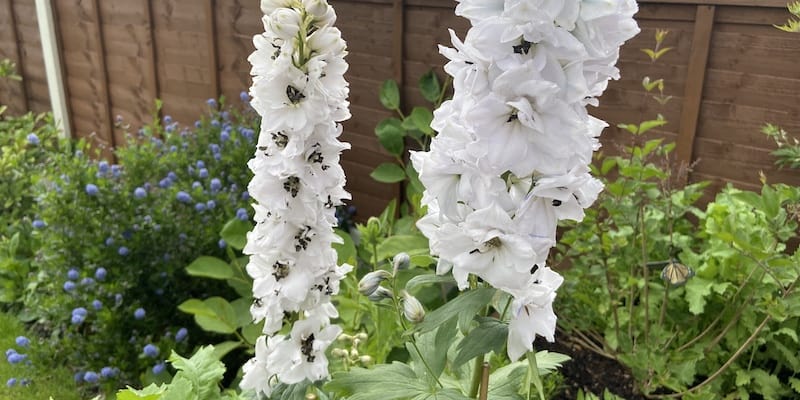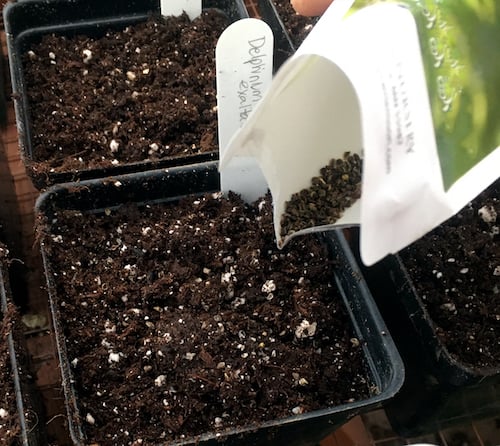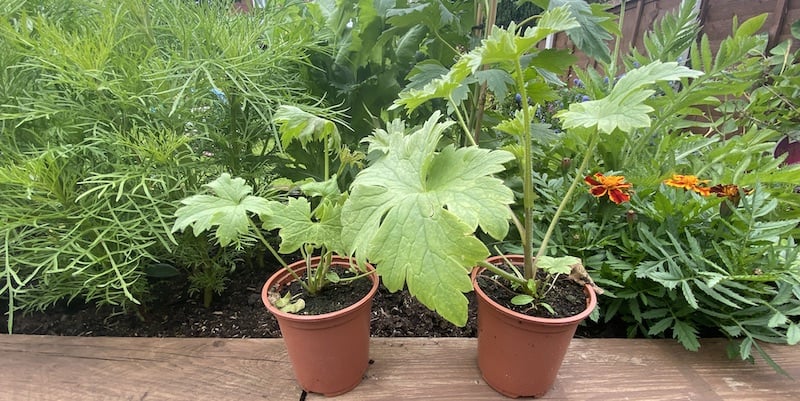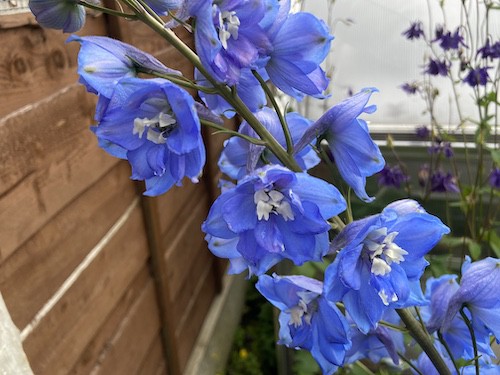
Growing delphiniums from seed – indoors and directly in the ground
Our site is reader supported, this means we may earn a small commission from Amazon and other affiliates when you buy through links on our site.
Growing delphiniums from seed is a low cost way of having these stunning flowers in your garden and following on from my guide on how to take cuttings as well as how to divide delphiniums. Growing delphiniums from seed involve carefully following a number of steps. You can sow the seeds indoors and then transplant them in your garden, or directly sow the seeds in the soil in your flowerbed. This article covers both methods but my preferred method is indoors as it’s faster but it’s a little more work.
Starting delphiniums from seed indoors
When to sow delphinium seeds
Late winter or early spring is the best time to sow seeds indoors for transplant outdoors in the spring. The flowers usually bloom within six months of sowing, so starting in January generally leads to colour in June of that year. If you buy your delphinium seeds before this time, store them in an airtight container in a fridge to keep them viable. I like to buy fresh seed of unusual varieties and sow them straight away.
Compost to use
Delphiniums like moist but well-drained soil. The seeds take two to three weeks to germinate so need to stay warm and watered throughout that period. Use multi-purpose compost. If it appears a bit thick or lumpy, add in some vermiculite or sand to give more drainage. Avoid loam-based composts as, though they retain moisture well, they can leave the seeds too wet.
Sow the seeds
Place a layer of moist compost in a tray or pot and sow the seeds thinly on top. Cover the seeds with a thin layer of compost to enclose them.
Thoroughly wet the compost. Placing the bottom of the tray of pot in a bowl of water of a few minutes lets the compost draw up all the water it needs.
Then cover the tray or pot. Use a propagator, polythene clear sheet or glass to keep the moisture in. Place the tray/pot out of direct sunlight and in a fairly cool (15˚C to 20˚C) place. Anywhere cooler than this can slow the germination process and anywhere warmer can harm the seed.
Check on the moisture level of the compost. As you’ve thoroughly wetted it out, you should not need to water it again before germination happens. But if the compost does dry out, add water slowly to restore the moisture amount.
Watch for germination
Watch for signs of green growth poking through the top layer of compost – this is germination. This usually happens sometime after 14 days after sowing the seeds. However, if nothing has appeared by day 28, then your seeds are probably not going to germinate.
Once a few seedlings (around 5 or so) have appeared, remove them from the propagator or remove whatever you covered the pots with. Move the tray/pot into good sunlight but still keep it out of direct sunlight which can kill the seedlings.
Keep the surface of the compost moist so that the other seeds can continue to germinate. If you have to frequently water the tray, replace the lid to keep the moisture inside. I actually like to keep the lid on my propagator and then open the vents.
Once the germination is almost complete, remove all the covers of the trays to increase ventilation to the seedlings and to start to harden them up.
Note: if you’re growing delphiniums from seed in small cells (small pots), you may need to transplant them to a larger pot during the germination process. This lets them grow thicker and stronger roots.
Harden off the seedlings
The first true delphinium leaves appear about three to four weeks after germination. Wait for a pair or two of these leaves to show up before pricking out and hardening off the plants.
Transplant each seedling into its own pot of compost. Make sure the compost stays moist but not wet, and is well drained.
Keep these new pots in full sunlight but out of direct sunlight. This is to start getting the seedlings used to the amount of sun they will receive outdoors. Continue to keep the pots in a cool environment, perhaps on a greenhouse bench or a sheltered windowsill.
Once the seedlings are well established in their new pots, start to move them outdoors for a few hours a day. Gradually increase this period until they’re outdoors for most of the daylight hours. Still continue to be careful to keep them sheltered from wind, heavy rain and any late frosts. Bring them inside if these weather conditions occur.
Plant outside
Once the seedlings’ roots fill their pots and they have three or more adult leaves, they’re ready for transplanting. This should be about mid-May to mid-June.
Plant each seedling in the ground of your flower bed about 60cm apart in well-drained and moist soil. Consider adding a spoonful of fertiliser to the planting hole.
Keep the soil moist by watering when dry or adding a mulch between the plants.
Care of the delphinium seedlings
Seedlings grow rapidly in the ground and produce a thick and sturdy flower stem. My article, How to grow and care for delphiniums, contains information on how to go from here, in helping your delphinium to continued good health.
I also have a guide on how to overwinter them here as well as common pests and diseases to watch our for here
If you notice the leaves getting yellow or brown then read this guide here and don’t forget to stake them once they flower as I do here
Sowing delphinium seeds straight into your flower bed
Sow the seeds in mid to late spring.
Choose an appropriate location for your delphinium patch, basically a sunny position in well-drained soil but you can also see How to grow and care for delphiniums for how to select the best location and soil.
Prepare the ground by creating a well-drained soil. You may need to add some sand or horiculual grit to ensure the best drainage. Remove any weeds. Work some good quality organic compost into the top 15cm or so of the ground.
Sow the seeds lightly and evenly on top of the soil. cover them with a thin layer of fine soil. lightly pack the soil down and then water it thoroughly and evenly.
The seedlings will show up in around 21 to 28 days.
When the seedlings each have three sets of leaves, you can thin them to a minimum of 45cm apart just leaving the strongest seedling in place or even pot some of the other ones into pots to grow further as gifts.


